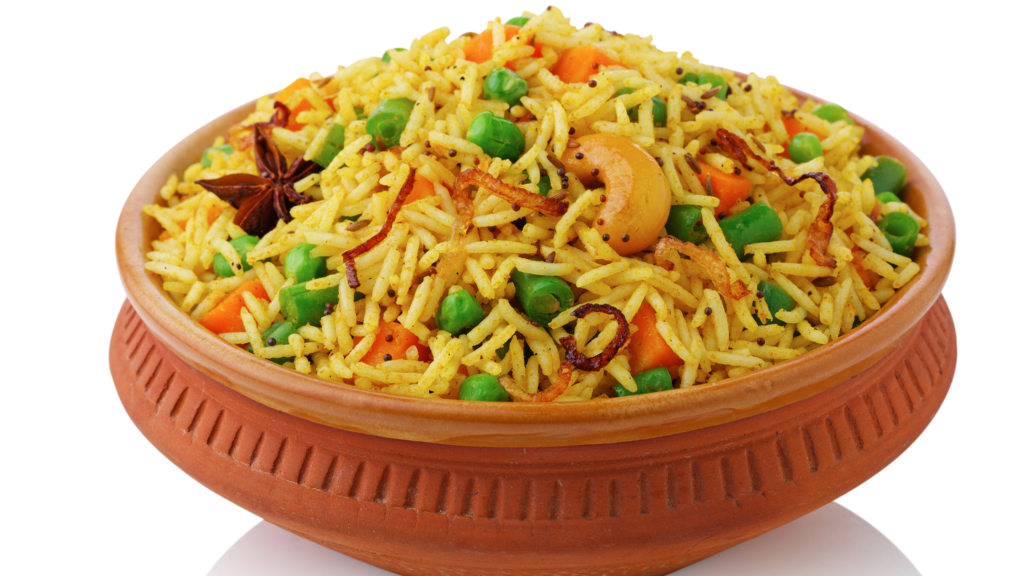Can Dogs Eat Yellow Rice? When it comes to our furry companions, it’s only natural to question what foods are safe and suitable for them.
One such query that often arises is whether dogs can enjoy the delightful flavors of yellow rice. After all, who wouldn’t want to share a tasty meal with their four-legged friend?
In this article, we aim to shed light on the topic and provide you with valuable information about the safety of feeding yellow rice to dogs.
So, let’s delve into the world of canine cuisine and discover whether our canine friends can partake in this vibrant and flavorful dish.
Understanding Yellow Rice

Yellow rice, also known as saffron rice or golden rice, is a delectable and aromatic dish that has gained popularity in diverse culinary traditions.
It is a rice dish with vibrant yellow color from adding various spices and seasonings. The primary ingredient in yellow rice is, of course, rice itself, typically long-grain rice.
However, the unique blend of spices and seasonings sets yellow rice apart, giving it its distinctive flavor and appearance.
The key ingredients in yellow rice may include fragrant spices such as turmeric, which contributes to its bright yellow hue, cumin, paprika, and sometimes saffron.
These spices lend a rich flavor profile and add a visually appealing touch to the dish.
Other ingredients commonly found in yellow rice include onions, garlic, and vegetable or chicken broth, which enhance the overall taste.
Yellow rice has found its place in various cuisines, including Indian, Latin American, Middle Eastern, and Asian.
It is a flavorful accompaniment to many dishes, from curries and stews to grilled meats and vegetables.
The enticing aroma and vibrant color of yellow rice make it a favorite among food enthusiasts worldwide.
Now that we have a basic understanding of yellow rice and its enticing ingredients let’s delve deeper into whether it is a suitable choice for our canine companions.
Safety Considerations: Can Dogs Eat Yellow Rice?

When feeding our furry friends, it’s crucial to be mindful of their dietary needs and potential health risks.
While yellow rice may be a flavorful and tempting dish for humans, there are certain safety considerations to remember before sharing it with our canine companions.
One primary concern regarding dogs and yellow rice is the inclusion of spices and seasonings.
Many yellow rice recipes contain ingredients like turmeric, cumin, and paprika, which can add robust flavors.
However, some spices may not be suitable for dogs in large quantities or under certain circumstances.
Turmeric, a key ingredient in yellow rice, contains curcumin, which is associated with potential health benefits.
However, it’s important to note that the curcumin in yellow rice is typically minimal.
While small amounts of turmeric may be safe for dogs, excessive consumption could lead to digestive upset or other adverse effects.
Additionally, certain spices and seasonings commonly used in yellow rice recipes, such as onions or garlic, can be toxic to dogs and should be avoided altogether.
To ensure the safety of our furry friends, it’s recommended to err on the side of caution and avoid feeding yellow rice to dogs, particularly if it contains any potentially harmful ingredients.
While a small taste of plain yellow rice without seasonings may not cause harm, it’s always best to prioritize their well-being and choose dog-specific food options to meet their nutritional needs.
Now that we’ve addressed the safety considerations associated with yellow rice and dogs, let’s explore alternative food choices that are safe and nutritious for our four-legged companions.
Also Read: Can Dogs Eat Pierogies? Are pierogies safe for dogs
Nutritional Value of Yellow Rice for Dogs
Yellow rice is known for its vibrant color and delightful flavor, but what about its nutritional value for our canine friends? Let’s look closer at the potential benefits of yellow rice and its key component, turmeric.
Yellow rice typically consists of long-grain rice infused with turmeric, which gives it the characteristic yellow hue.
Turmeric contains curcumin, which is known for its anti-inflammatory and antioxidant properties. These properties have been studied for their potential health benefits in humans.
While dogs may not necessarily reap the same benefits from turmeric as humans, it’s worth noting that small amounts of turmeric can still offer some advantages.
Curcumin has been associated with aiding digestion, promoting a healthy immune system, and supporting joint health, among other potential benefits.
However, it’s important to remember that turmeric in yellow rice is generally minimal, and its impact on dogs’ overall health is not fully understood.
When it comes to the nutritional content of yellow rice, it primarily consists of carbohydrates, providing energy for our furry friends.
However, it lacks essential nutrients, such as proteins, vitamins, and minerals, vital for a well-rounded dog diet.
Therefore, while yellow rice may be tasty, it should not be relied upon as a primary source of nutrition for dogs.
To ensure that your dog receives a well-balanced diet, it’s essential to offer a variety of specially formulated dog food that meets its nutritional needs.
These foods are carefully crafted to balance proteins, fats, carbohydrates, vitamins, and minerals necessary for their overall health and well-being.
While a taste of plain yellow rice without seasonings may not pose a significant risk to dogs, it’s essential to prioritize their nutritional requirements and consult with a veterinarian regarding any potential dietary changes.
Now that we’ve explored yellow rice’s nutritional value let’s delve into the importance of moderation and portion control when introducing new foods to our furry friends’ diets.
Feeding Yellow Rice to Dogs: Guidelines and Moderation
Suppose you’ve consulted with your veterinarian, who has given the green light to incorporate yellow rice into your dog’s diet.
In that case, following some guidelines and practicing moderation is important to ensure their well-being.
Here are a few tips to help you introduce yellow rice to your furry friend’s meals:
1. Start Slowly: Start by offering your dog a small amount of cooked plain yellow rice. Observe their reaction and any signs of digestive distress. If everything goes well, you can gradually increase the portion size over time.
2. Plain and Simple: It’s crucial to serve yellow rice without adding spices, seasonings, or ingredients that may harm dogs. Stick to plain cooked rice to avoid any potential digestive upset.
3. Portion Control: Yellow rice should only make up a small portion of your dog’s overall meal. It should never replace their regular balanced dog food, specially formulated to meet their nutritional needs. Use yellow rice as an occasional treat or mix it in with their regular food as an occasional addition.
4. Monitor Digestive Health: Keep a close eye on your dog’s digestion after introducing yellow rice. Watch for signs of upset stomach, diarrhea, or other digestive issues. If you notice any adverse reactions, discontinue feeding yellow rice and consult your veterinarian.
5. Balance and Variety: Remember that dogs thrive on a balanced diet that includes a variety of nutrients. While yellow rice can add flavor and variety to their meals, it should not become the mainstay of their diet. Ensure they receive a well-rounded diet with high-quality dog food formulated for their needs.
Moderation is key when it comes to feeding yellow rice to dogs.
While it can occasionally add to their meals, it should never replace their regular diet or compromise their nutritional requirements.
Always consult your veterinarian before making significant changes to your dog’s diet.
Considerations for Dogs with Specific Health Conditions
While yellow rice may be safe for some dogs, it’s essential to consider any specific health conditions or dietary restrictions your furry companion may have. Here are a few considerations to keep in mind:
1. Allergies and Sensitivities: If your dog has known allergies or sensitivities to certain ingredients, it’s crucial to evaluate whether yellow rice contains any potential allergens.
Some dogs may be allergic to grains or spices commonly found in yellow rice, such as turmeric. It’s best to consult your veterinarian to determine if yellow rice suits your dog’s allergies or sensitivities.
2. Digestive Disorders: Dogs with pre-existing digestive disorders, such as pancreatitis or inflammatory bowel disease (IBD), may have sensitivities to certain foods, including rice.
The high carbohydrate content in rice can sometimes exacerbate these conditions. Your veterinarian can guide whether yellow rice is appropriate for your dog’s digestive health needs.
3. Restricted Diets: If your dog is on a restricted or specialized diet due to a medical condition, such as kidney disease or diabetes, introducing yellow rice may not align with their dietary requirements.
These conditions often require precise control over the nutrients and ingredients in your dog’s meals. It’s crucial to consult with your veterinarian to ensure that yellow rice fits within their dietary restrictions.
4. Veterinary Guidance: Regardless of your dog’s health condition, it’s always recommended to seek professional advice from your veterinarian before making any significant changes to their diet.
Your veterinarian knows your dog’s specific health history and can provide personalized recommendations based on their needs.
Remember, every dog is unique, and what works for one may not work for another.
Your veterinarian is the best resource to guide you on whether yellow rice suits your dog’s health conditions and dietary requirements.
They can help you make informed decisions and create a diet plan promoting your dog’s well-being.
Also Read: 4 Best Dog Training Apron Guide: Mastering Dog Training
Conclusion – Can dogs eat yellow rice?
In conclusion, whether dogs can eat yellow rice requires careful consideration. While yellow rice may be safe for some dogs, it’s crucial to understand the potential risks and consider individual circumstances. Let’s recap the key points we’ve discussed:
Yellow rice is a flavorful dish with various ingredients, such as rice, spices, and seasonings.
Feeding yellow rice to dogs poses safety considerations due to the potential presence of spices, seasonings, or ingredients that may be harmful or problematic for dogs.
The nutritional value of yellow rice for dogs may vary, but it typically contains carbohydrates and some trace nutrients. Turmeric, a common ingredient in yellow rice, is known for its potential health properties.
When introducing yellow rice to your dog’s diet, following guidelines and practicing moderation to avoid digestive issues is essential.
Considerations for dogs with specific health conditions, allergies, sensitivities, or restricted diets are crucial. Consulting with a veterinarian is paramount to ensure the safety and well-being of your dog.
Ultimately, prioritizing your dog’s well-being is of utmost importance. Consultation with a veterinarian is recommended to determine whether yellow rice suits your dog’s needs.
Remember, plenty of safe and suitable alternatives are available to provide a balanced and nutritious diet for your canine companion. Your veterinarian can help you explore these options and create a customized diet plan for your dog’s optimal health.
By staying informed, seeking professional advice, and considering your dog’s unique circumstances, you can make responsible choices to provide the best nutrition and care. Your furry friend will thank you for it with their vibrant health and boundless energy.
